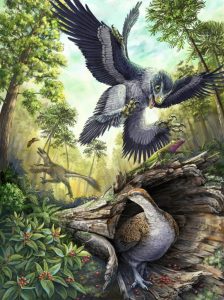
A new study shows that teeth are not too good for you if you’re a dinosaur trying to not go extinct.
Around 66 million years ago, a time known as the end-Cretaceous, there was a massive extinction of life, with around 75% of all known species dying off. Perhaps most well-known at this time is the extinction of the non-bird line dinosaurs.
We’ve known about this extinction for decades now. But in spite of this, the causes, timing, and ecology of it still remain fairly elusive and highly debated. This is quite important for figuring out what triggered the origins of modern birds, as their radiation has been thought to be closely related to the extinction of their close dinosaurian cousins.
New research on maniraptoran dinosaurs, the group that includes Velociraptor and modern birds, shows that having a beak conferred a survival advantage by providing birds the ability to eat seeds. When animals around you are dying off in droves because meteor strike, this would have come in pretty handy by being able to exploit dwindling food resources.
Teeth are particularly handy for studies like this, as not only are they relatively frequent in the fossil record, but they also reveal to us much about the ecology of dinosaurs at this time, such as what they ate.
One way to measure ecology quantitatively is through something called disparity. This is a measure of the diversity of different types of anatomy, which can be related to specific functions. A simple measure of disparity might be the curvature of the tooth, or the distance from the root to the crown.
The team analysed more than 3100 of these teeth from different dinosaur groups to see how disparity changed through time coming up to the end-Cretaceous extinction boundary. What they found is that up until the extinction, disparity remained pretty high in theropod dinosaur groups such as dromaeosaurs and troodontids, including birds. This is what we might think of then as ‘ecosystem stability’, with consistency in the variation of maniraptorans throughout this time.
“We’ve used the teeth of these bird-like dinosaurs to show that these dinosaurs were a consistent and stable part of the ecosystem leading up to the end of the Cretaceous,” explained lead author of the study Derek Larson, assistant curator at the Philip J. Currie Dinosaur Museum and PhD candidate at the University of Toronto.
What this means is that the extinction was fairly instantaneous, and not drawn out over a long period of time. Therefore, it is more likely that aspects relating to this such as diet were more important, and in particular the evolution of the beak in birds.
In particular, one striking difference between small maniraptorans and early birds at this time is the presence of a keratin-sheathed beak in the latter group. In dinosaurs, the acquisition of a beak was a key characteristic in their survival and subsequent evolution. Even today, there are more than 10,000 species of bird, highlighting the success this evolutionary innovation gave to them.
Larson explained, “By analysing the known diets of modern birds, we can see many groups that probably survived the extinction could have survived by eating seeds, probably one of the few plentiful resources that were available in the climatic upheaval in the aftermath of the asteroid impact. Those dinosaurs without a beak and without the right teeth to access those resources, would have been relegated to extinction.”
This story based on fossils actually fits in quite nicely with what studies of the DNA of modern birds tells us. Using modelling approaches, we can tell that early birds around this time where granivorous, that is they ate seeds either entirely or as part of a mixed diet.
This is really important, as it shows that as food webs collapsed due to the end-Cretaceous meteor strike, being able to survive of seeds might have been critical in the survival of modern birds. This is similar to what we observe during forest fires, with some birds the first to recolonise damaged areas due to the abundance of left over seeds.
So I guess the real question now is, what if T. rex had a beak..?
Reference:
Derek W. Larson et al. Dental Disparity and Ecological Stability in Bird-like Dinosaurs prior to the End-Cretaceous Mass Extinction, Current Biology (2016). DOI: 10.1016/j.cub.2016.03.039
Note: The above post is reprinted from materials provided by Public Library of Science.










